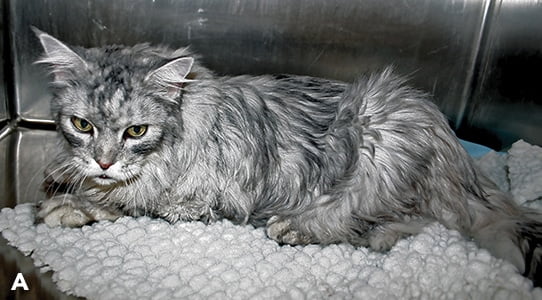I am not a veterinarian so rather than discussing in detail the causes and cures of type II diabetes in domestic cats, I have decided to tell 3 stories about 3 cats. The stories come from Elizabeth Hodgkins’ book, Your Cat, which is essentially about dry cat food and how it can gradually cause illnesses including type II diabetes if the cat is predisposed. What is surprising about these stories is that all 3 of these cats had type II diabetes although in two cases it appears that the owner did not know it. The third cat was on insulin and therefore was a known diabetic.

Maggie
Dr Hodgkins tells us that Maggie was 10 years of age when she saw her. She had been fed high quality dry cat food for a long time with the occasional treat of wet. She had been healthy for 10 years and suddenly had lost her health. She wasn’t overweight. She started to lose weight and began to eat poorly and was drinking a lot. A blood test showed that her blood sugar level was 410 mg/dL. The normal level should be between 50 and 120 milligrams per decilitre. She was hospitalised and fed canned food only and by the 3rd day her blood sugar level was 100 milligrams per decilitre. She didn’t require insulin and her average blood sugar level remained at 90 milligrams per decilitre. She gained weight and is doing okay.
Goldstein
Goldstein was an 8 year old neutered male domestic shorthaired tabby. He was well loved. He had been fed commercial dry food exclusively his entire life. Very suddenly he began drinking a lot and going to the litter box more often. He was overweight at 14 pounds but otherwise in good condition. Dr. Hodgkins took a blood sample and the blood sugar level read 490 milligrams per decilitre. He was hospitalised and fed canned food only. His blood sugar level dropped significantly but not enough to avoid treating him with insulin and by the 3rd day is blood sugar was between 100 milligrams per decilitre and 150 milligrams per dL. A week later it had dropped to 60 mg/dL. He was taken off insulin. For the next year he did not require insulin injections. As far as I know he never did.
Rascal
Rascal was a 6 year old neutered male shorthaired cat. He weigh 20 pounds and was overweight. He had been diagnosed diabetic. He was getting insulin twice a day. He was eating a high carbohydrate dry food diet formulated for diabetic cats. His insulin levels were being adjusted by his veterinarian. Sometimes his blood sugar level was very high at 520 mg/dL. On these occasions his insulin dose was increased. Sometimes his blood sugar level dropped to dangerously low levels. It was a seesaw between high and low blood sugar levels. When Dr Hodgkins saw Rascal he had flaky dandruff on his skin and his coat was dull and dry. He drank lots of water and urinated 10 times per day. He was always hungry and would steal human food. He was receiving 6 units of insulin every 12 hours.
He was hospitalised and his blood sugar ranged between 300 and 450 mg/dL despite being given insulin. His insulin was stopped in his diet changed to a low-carbohydrate canned food diet. Initially he didn’t like the wet food because he was used to a high carbohydrate dry diet. He was carbohydrate addicted according to the doctor. His blood sugar level gradually declined. He was given insulin still and his blood sugar level continued to decline but ranged between 125 and 200 milligrams per decilitre. He lost his excessive thirst and urination and started to enjoy his canned food. His caretaker was taught to use a device to read his blood sugar levels. The blood sugar levels declined but varied between 60 and 150 mg/dL. The doctor stopped the insulin treatment for one day and his blood sugar level climbed to over 200 at the highest. Gradually the insulin treatment was reduced and after 3 months he was off insulin altogether. 8 months later he had lost 3 pounds and his coat looked better. He went to the toilet 3 to 4 times daily and drank much less water because the food he ate contained water. His dandruff disappeared and he no longer begged for food all the time. His blood sugar levels continued to be tested when the story ended. In short there was a massive improvement because of a change of diet to wet cat food.
Conclusion
You have to make your own conclusions. My conclusion is that type II diabetes can creep up on a domestic cat and cause health issues without the owner being aware of the underlying medical issues including diabetes if the cat is predisposed. Long-term dry cat food can create this situation. The cat’s body is unable to cope with the heavy carbohydrate load and the pancreas malfunctions (the pancreas makes insulin). Obesity can also cause problems with insulin resistance. The liver’s action is linked to the pancreas but you can discuss that with a veterinarian.
The point that I am making in this post is that if you see a similarity with respect to the symptoms described I would suggest that you discuss it with your veterinarian and ask him to do a blood test for sugar levels and go from there but start with the possibility of curing the problem with an exclusive wet food diet.

